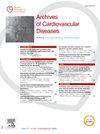Inflammation and induced-macrophages recruitment in non-syndromic mitral valve dystrophy
IF 2.3
3区 医学
Q2 CARDIAC & CARDIOVASCULAR SYSTEMS
引用次数: 0
Abstract
Introduction
Mitral Valve Prolapse is a common disease affecting 2 to 3% of the population, characterized by a myxomatous mitral valve dystrophy (MVD). Based on the analysis of the FlnA-P637Q KI rat model of non-syndromic MVD, we highlighted that chemotaxis and immune cell migration played a central role in the pathogenesis of MVD, although MVD has been considered so far as a non-inflammatory disease.
Objective
To delineate the role of immune cells, specifically macrophages, in MVD pathophysiology.
Method
MVD samples from 78 patients with sporadic severe MV regurgitation were sequenced by bulk RNA-seq. KI and WT animals were then studied from birth (D0) to D21 by histology, immunohistology, and flow cytometry to characterize the kinetic of MVD development and the activation/recruitment of macrophages. Bulk RNA-seq was also performed at D7.
Results
The transcriptomic analysis of human “end-stage” MVD samples highlighted the activation of signaling pathways related to myxomatous ECM remodeling, valvular cell activation, and TGF-β/BMP, as well as the involvement of leucocyte migration and immune response. Deconvolution algorithm confirmed an enrichment in macrophages. Interestingly, human and D21 rat MVD shared common molecular signature (51% concordance between the top 2000 highly expressed genes), confirming the pertinence of the rat model. Flow cytometry at D21 revealed a 2-fold increase of macrophage in KI MV compared to WT (13% vs 7%, P < 0.05). At the early timepoint (D0 and D2), no MVD was detected, although molecular markers of the disease were already overexpressed. At D7, we reported the presence of MVD in KI rats (histological score: 7 vs 4, P < 0.001), without increased proportion of macrophages (7% vs 6%, P = 0.63). Transcriptomic analysis of D7 MV revealed an enrichment in GO-Terms related to morphogenesis, ECM and cytoskeleton organization, cell activation, as well as a consistent activation of chemotaxis and cytokines activity.
Conclusion
This study confirmed a significant contribution of macrophages in the process leading to human MVD. Relying on the sequential analysis of the rat model, we reported a gradual activation of the MVD pathophysiological mechanisms following birth, that further translated to a detectable MVD as early as D7, and in turn lead to the recruitment of macrophages. This study supports the central role of macrophages in the disease development and progression, and open new avenues to develop medical therapy.
非综合征性二尖瓣营养不良的炎症和诱导巨噬细胞募集
二尖瓣脱垂是一种常见病,影响2 - 3%的人群,其特征是粘液瘤性二尖瓣营养不良(MVD)。基于对FlnA-P637Q KI大鼠非综合征性MVD模型的分析,我们强调趋化性和免疫细胞迁移在MVD的发病机制中发挥了核心作用,尽管MVD迄今为止被认为是一种非炎症性疾病。目的探讨免疫细胞特别是巨噬细胞在MVD病理生理中的作用。方法对78例散发性重度中压反流患者的mvd样本进行大量rna测序。然后对KI和WT动物从出生(D0)到D21进行组织学、免疫组织学和流式细胞术研究,以表征MVD发育的动力学和巨噬细胞的激活/募集。D7时也进行了大量rna测序。结果人类“终末期”MVD样本的转录组学分析强调了与黏液瘤ECM重塑、瓣膜细胞活化和TGF-β/BMP相关的信号通路的激活,以及白细胞迁移和免疫应答的参与。反卷积算法证实了巨噬细胞的富集。有趣的是,人类和D21大鼠MVD具有共同的分子特征(前2000个高表达基因之间有51%的一致性),证实了大鼠模型的相关性。D21时的流式细胞术显示KI MV中的巨噬细胞比WT增加了2倍(13% vs 7%, P <;0.05)。在早期时间点(D0和D2),虽然疾病的分子标记物已经过表达,但未检测到MVD。在D7时,我们报道了KI大鼠中MVD的存在(组织学评分:7 vs 4, P <;0.001),巨噬细胞比例未增加(7% vs 6%, P = 0.63)。转录组学分析显示,D7 MV富含与形态发生、ECM和细胞骨架组织、细胞活化以及趋化性和细胞因子活性相关的GO-Terms。结论本研究证实巨噬细胞在人MVD的形成过程中起重要作用。根据对大鼠模型的序列分析,我们报道了出生后MVD病理生理机制的逐渐激活,这进一步转化为早在D7时可检测到的MVD,并反过来导致巨噬细胞的募集。本研究支持巨噬细胞在疾病发生和发展中的核心作用,并为开发药物治疗开辟了新的途径。
本文章由计算机程序翻译,如有差异,请以英文原文为准。
求助全文
约1分钟内获得全文
求助全文
来源期刊

Archives of Cardiovascular Diseases
医学-心血管系统
CiteScore
4.40
自引率
6.70%
发文量
87
审稿时长
34 days
期刊介绍:
The Journal publishes original peer-reviewed clinical and research articles, epidemiological studies, new methodological clinical approaches, review articles and editorials. Topics covered include coronary artery and valve diseases, interventional and pediatric cardiology, cardiovascular surgery, cardiomyopathy and heart failure, arrhythmias and stimulation, cardiovascular imaging, vascular medicine and hypertension, epidemiology and risk factors, and large multicenter studies. Archives of Cardiovascular Diseases also publishes abstracts of papers presented at the annual sessions of the Journées Européennes de la Société Française de Cardiologie and the guidelines edited by the French Society of Cardiology.
 求助内容:
求助内容: 应助结果提醒方式:
应助结果提醒方式:


